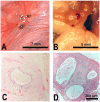WERF Endometriosis Phenome and Biobanking Harmonisation Project for Experimental Models in Endometriosis Research (EPHect-EM-Heterologous): heterologous rodent models
- PMID: 40628402
- PMCID: PMC12237513
- DOI: 10.1093/molehr/gaaf022
WERF Endometriosis Phenome and Biobanking Harmonisation Project for Experimental Models in Endometriosis Research (EPHect-EM-Heterologous): heterologous rodent models
Erratum in
-
Correction to: WERF Endometriosis Phenome and Biobanking Harmonisation Project for Experimental Models in Endometriosis Research (EPHect-EM-Heterologous): heterologous rodent models.Mol Hum Reprod. 2025 Jul 3;31(3):gaaf033. doi: 10.1093/molehr/gaaf033. Mol Hum Reprod. 2025. PMID: 40726118 Free PMC article. No abstract available.
Abstract
Endometriosis, defined as the growth of endometrial-like tissues outside the uterus, is a common disease among women. Numerous in vivo rodent models of endometriosis have been developed to explore multiple aspects of this poorly understood disease. Heterologous models utilize human endometrial tissues engrafted into immunocompromized mice, while homologous models engraft rodent endometrium into immunocompetent mice or rats. Heterologous models of endometriosis more closely replicate the human disease; however, the murine humoral immune response must be suppressed to prevent rejection of the xenograft tissue. Although the innate immune system remains intact, suppression of the humoral response leads to a markedly different local and systemic immune environments compared to humans. Despite this limitation, experiments using heterologous models have contributed significantly to our understanding of endometriosis establishment and progression, the pre-clinical effectiveness of various therapeutic strategies, and genetically modifiable host factors that contribute to disease. Unfortunately, a lack of harmonization of the models used by different laboratories has impeded the reproducibility and comparability of results between groups. Therefore, the World Endometriosis Research Foundation (WERF) formed an international working group of experts in heterologous models of endometriosis to develop guidelines and protocols that could contribute to unifying experimental approaches across laboratories. Nine critical variables were identified: (i) mouse strain; (ii) human tissue type; (iii) hormonal status of the human tissue donor; (iv) human tissue preparation; (v) method and location of tissue placement; (vi) hormonal status of the recipient animal; (vii) whether or not mice were engrafted with human immune cells; (viii) endpoint assessments; and (ix) number and type of replicates. Herein, we outline important considerations for each major variable and make recommendations for unification of approaches. Widespread adoption of harmonized protocols and implementation of standardized documentation and reporting should further improve the reproducibility and translation of experimental findings both within and between laboratories.
Keywords: collaboration; endometriosis; experimental models; heterologous; research; rodents.
© The Author(s) 2025. Published by Oxford University Press on behalf of European Society of Human Reproduction and Embryology.
Conflict of interest statement
K.L.B.-T. is a trustee of WERF. E.G. is a member of the scientific advisory board of FimmCyte AG and a trustee of WERF. M.L.H. is a director of Embrace Fertility (Adelaide, Australia) and reports grants from the Australian MRFF, Endometriosis Australia, Australasian Society of Ultrasound in Medicine, Robinson Research Institute and the Australian Gynaecological Endoscopy Society, Jean Hailes Development Fund, Australian Department of Health, as well as paid honoraria from Merck, MSD, Ferring, Guerbert, Myovant, Bayer, Gideon Richter, and is a member of the ASPIRE Scientific Committee, and the Jean Hailes Governance Committee. She has additionally received travel funding and educational support from Gideon Richter, Orgnanon, Merck, Besins, and Ferring and research funding from Guerbet, Myovant, Dare, and Alyra. None of her funding is related to this work. L.H. received remuneration from WERF as the EPHect programme manager and has provided consultancy to Gesynta Pharma AS, which has no bearing on this work. S.A.M. is a trustee of WERF, co-principal investigator of EPHect, a past president of the World Endometriosis Society (WES), and a member of the scientific advisory board of NextGen Jane; she has received presentation remuneration from Gideon Richter, and research funding from AbbVie, LLC, the Marriott Family Foundations, the USA National Institutes of Health (NIH), and the USA Peer Reviewed Medical Research Program (PRMRP), none of which is related to this work. K.A.B., R.G., I.R.L., W.B.N., and M.Z.J. declare no conflicts of interest.
Figures



References
-
- Ahmad SF, Akoum A, Horne AW. Selective modulation of the prostaglandin F2alpha pathway markedly impacts on endometriosis progression in a xenograft mouse model. Mol Hum Reprod 2015;21:905–916. - PubMed
-
- Alt FW, Rathbun G, Oltz E, Taccioli G, Shinkai Y. Function and control of recombination-activating gene activity. Ann N Y Acad Sci 1992;651:277–294. - PubMed
-
- Aoki D, Katsuki Y, Shimizu A, Kakinuma C, Nozawa S. Successful heterotransplantation of human endometrium in SCID mice. Obstet Gynecol 1994;83:220–228. - PubMed
Publication types
MeSH terms
Grants and funding
LinkOut - more resources
Full Text Sources
Medical

